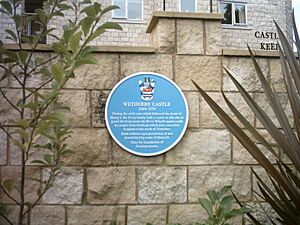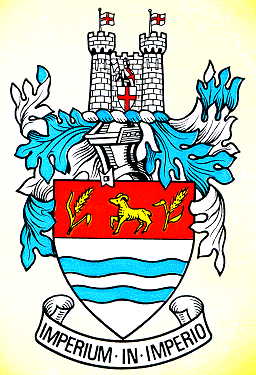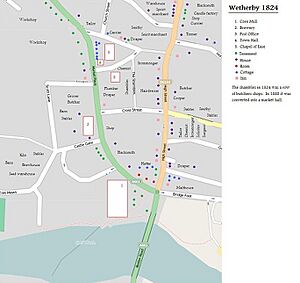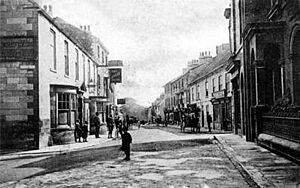History of Wetherby facts for kids
The story of Wetherby, a busy market town in West Yorkshire, England, began a long time ago. Its history started in the 12th and 13th centuries. This was when groups of knights, first the Knights Templar and then the Knights Hospitallers, were given land and buildings in Yorkshire.
In 1240, the Knights Templar received special permission from King Henry III. This allowed them to hold a market in Wetherby every Thursday. They could also have a big fair once a year, lasting three days around the day of St James the Apostle.
Between 1318 and 1319, areas in the North of England, including Wetherby, faced many attacks from the Scots. After a big battle called the Battle of Bannockburn, Wetherby was burned down. Many people were captured or killed. Some believe Wetherby might even be named after these Scottish raiders.
In 1233, the Archbishop of York offered forgiveness for sins to anyone who helped build the Wetherby Bridge.
Contents
- Wetherby Castle: A Hidden History
- English Civil War: A Brief Stop
- Cattle Droving: Wetherby's Busy Past
- The Great Sale of Wetherby in 1824
- The Victorian Era: Growth and Change
- Twentieth Century: Wars and Modernisation
- Twenty-First Century: More Changes
- Blue Plaques: Marking History
- See also
- Images for kids
Wetherby Castle: A Hidden History

For about 15 years, Wetherby had a castle! It was built in 1140 by the Percy family. They built it to protect the crossing point over the River Wharfe. This was especially important because Scottish raiders often attacked the area. At that time, the Scots controlled much of England north of Yorkshire.
However, in 1155, King Henry II ordered the castle to be pulled down. Today, only its foundations remain, mostly hidden underground. In recent years, new homes called 'Castle Keep' were built on the site. A special blue plaque now marks this historic spot.
English Civil War: A Brief Stop
Wetherby played a small part in the English Civil War in 1644. This was a big fight between the King and Parliament. Before a major battle at Marston Moor, the Parliamentarian army stayed in Wetherby for two days. They were joining forces with Scottish soldiers. A famous leader, Oliver Cromwell, even stayed nearby in Collingham.
Cattle Droving: Wetherby's Busy Past
From the 1650s to the 1850s, Wetherby was a very important place for moving cattle. Thousands of cattle were walked all the way from the Scottish Highlands to the London meat market. Wetherby was a key stop on this long journey. It was on the Great North Road and had a major crossing over the River Wharfe.
During the time of Napoleon, even more cattle were needed. They were used to provide salted beef for soldiers and sailors. Scottish drovers would gather huge herds of cattle, sometimes tens of thousands!
These cattle were then grouped into herds of about 200. They were even given metal shoes for their long, four-week walk. Wetherby's market, which started in 1240, was a place where drovers could trade sick or tired cattle for healthy ones. This steady trade helped Wetherby become a rich and confident town for many years.
Over time, new toll roads made it harder for drovers to move their cattle freely. Also, land became more valuable for farming. This meant the free grazing spots for cattle became harder to find.
The cattle droving business finally ended in the mid-1850s. This was because of new inventions like railways, steamships, and refrigeration.
The Great Sale of Wetherby in 1824
In 1824, the Duke of Devonshire decided to sell almost the entire town of Wetherby! He did this to get money for work on his grand house, Chatsworth. The sale included many houses, businesses, a mill, and even a brewery.
The sale catalogue listed "nearly 200 dwellings," "Two Posting Houses, Three Inns, and Seven Public Houses." It also mentioned "The Valuable Manor of Wetherby" and "Upwards of 1300 acres." The catalogue described Wetherby as an important stop on the main road from Ferrybridge to Glasgow.
On the first day of the sale, a famous inn called the Swan and Talbot sold for £1,510. On the second day, other inns like the Crown, the Red Lion, and the Blue Boar sold for £2,870.
Here's an example from the sale catalogue about The Crown Inn:
Lot Number: 66
Occupiers: Widow Smith
Description: The Crown Inn, on High Street, had many rooms, a cellar, and four bedrooms. In the back yard, there was a brewhouse, storage, a coal house, a barn, a cow house, and stables for horses. This property even reached onto the market place.
The Victorian Era: Growth and Change
Industrialisation in Wetherby
During the Victorian times, Wetherby was mostly a country town. But it was also the main town for the areas around it, especially because of its cattle market. Wetherby started to become more industrial during this period. Local businesses like the brewery and mill grew. A factory was also built by Teesdale and Metcalf. Even though Wetherby's industrial growth wasn't huge, the town still changed and grew during the Industrial Revolution.
The Arrival of Railways
In the 1830s, two mail coaches visited the Angel public house every day. Then, in the 1840s, a railway line was built connecting Harrogate to Church Fenton. By the 1860s, the local newspaper, the Wetherby News, pushed for Wetherby to be linked to Leeds by train.
In 1866, the NER started building the line from Cross Gates to Wetherby. This finally connected Wetherby to Leeds. A new railway station was built. The old station is now a dance hall called The Old Engine Shed. When the railway was open, special trains would run from Bradford Interchange to Wetherby on race days.
Town Utilities
Wetherby Gasworks opened in 1852. It had two large gas holders and closed in the late 1970s. Wetherby also had a concrete water tower, which was taken down in 1959. Even though the gasworks no longer produce gas, a gas site still exists in the area.
Twentieth Century: Wars and Modernisation
Wetherby at the Start of the 1900s
Around the early 20th century, Wetherby had a mix of different businesses. There was a large mill that employed many people. The cattle market and the town's many inns were still important. These inns served travelers on the A1 road. However, the growth of railways in the 19th century meant Wetherby was less important as a stop on the main road. By this time, Wetherby had train links to Leeds, Harrogate, and York. It also had its own gas works.
The World Wars and Wetherby
Like many towns in West Yorkshire, Wetherby lost many people in the First World War. Many men from Wetherby were part of the Leeds Pals regiment. This group suffered huge losses in the Battle of the Somme. During the war, many Wetherby residents worked at the Barnbow munitions works in Cross Gates. A memorial for those lost in the war was built near the town bridge in 1922.
During the Second World War, Wetherby had a special naval training base called HMS Ceres. It was located where Wetherby High School is now. A large munitions factory, ROF Thorp Arch, was also built nearby. This factory provided jobs for many people during the war. However, Wetherby does not have a memorial for its losses in the Second World War.
The Brewery and Mill Change
For many years, Wetherby was home to the Wharfedale Brewery. This later became a mineral water factory. The factory was taken down in the 1950s. The site was then rebuilt as a bus depot and bus station. Today, it has shops, offices, and a restaurant. The old watermill by the weir is now a place with fancy riverside flats.
The End of the Railways
Both railway lines that served Wetherby closed in 1965. This was part of a big plan to cut railway costs across the country. After the railways closed, there were ideas to turn the old line into a new road through the town. But these plans never happened. Instead, part of the old railway line is now a cycle track called the Harland Way. It connects Wetherby with Spofforth.
Town Centre Makeover
Throughout the 1960s, the town council discussed how to make the town centre bigger. They wanted to handle more people and build a proper supermarket. There were ideas to make High Street and North Street into pedestrian-only areas.
In the end, it was decided to build a special shopping area. This was built in the 1970s and was updated a lot in 2003. By 2006, the open parts of the Horsefair Centre were covered with a glass roof.
Bypassing Wetherby: New Roads
The first bypass road around Wetherby was built between 1957 and 1959. This road helped traffic avoid the town centre. For many years, the bypass started at a roundabout that often had long queues. The A1 road was later moved in 1988 to improve traffic flow.
In 2004, the northern part of the bypass was changed again to a new section of the A1(M) motorway. This helped traffic bypass Kirk Deighton. More upgrades to the A1 continued, including a new motorway service station near Wetherby.
Industrial Growth in the 20th Century
Even though Wetherby's mill and brewery closed in the 20th century, new industrial areas grew. These included the Sandbeck Industrial Estate and the nearby Thorp Arch Trading Estate. The Thorp Arch estate was first built as munitions factories during the Second World War. It brought many employers to the area, like companies making electronic parts, packaging, and food products.
Twenty-First Century: More Changes
Bypassing Wetherby Again
In the early 2000s, the original Wetherby bypass became too busy. So, it was upgraded in two stages. The road was moved further east, and new junctions were opened. The Wetherby Service Station opened in 2008. More road improvements are planned for the area.
Redeveloping the Horsefair Centre
After the 1990s, the Morrisons supermarket in the Horsefair Centre became too small. The car park also needed to be bigger. So, throughout the 1990s and 2000s, the car park was made larger. In 2003, the old supermarket was taken down. A new, much bigger Morrisons store opened in 2004. This meant the Post Office had to move to a new spot. In 2005, work began to cover the western part of the shopping centre with a glass roof, which was finished in 2006.
Blue Plaques: Marking History
Wetherby Town Council has put up special blue plaques to mark important historical places. These plaques can be found at the site of the old castle, the former watermill, the town hall, and several old inns and churches. Wetherby doesn't have its own museum, but its history is well recorded at Leeds Central Library.
See also
- History of Hunslet
- History of Kirkstall
- History of Leeds
- History of Seacroft
Images for kids
-
Http://www.elliott99.plus.com/Richard/images/scott lane400x400.jpg
A blue plaque at the entrance to Scott Lane.





